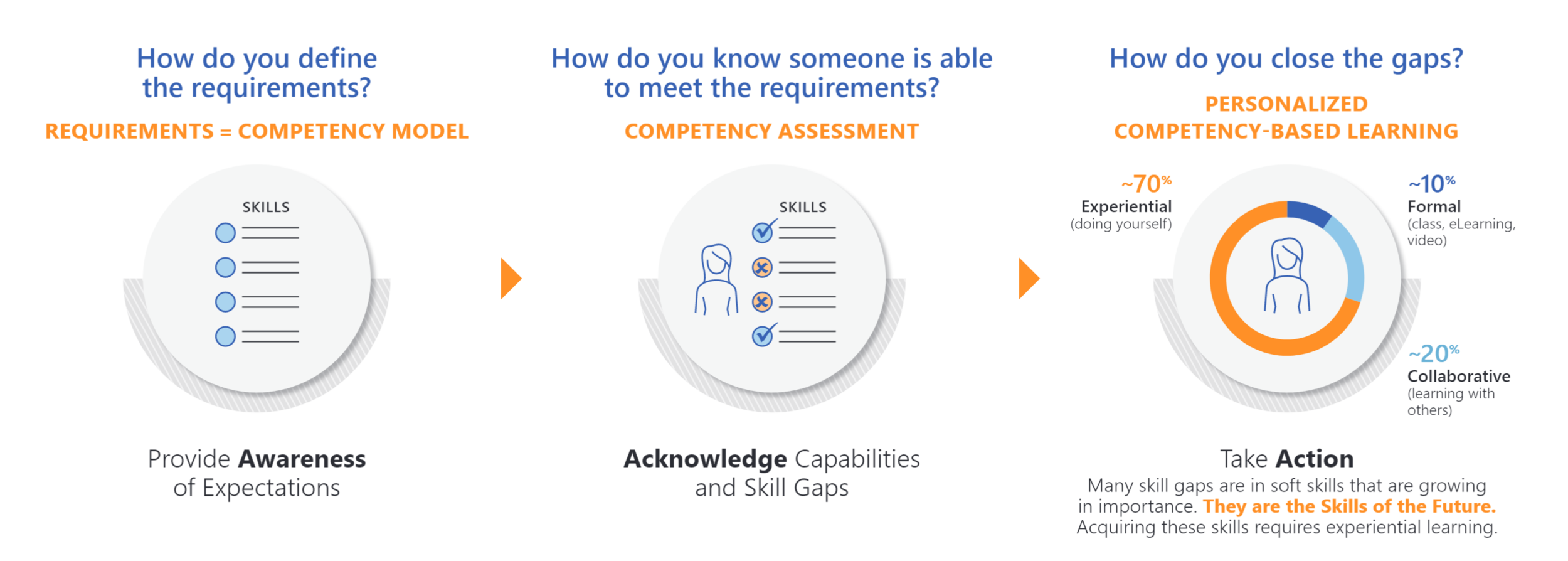How could I use a competency model? Let me count the ways!
We’re often asked, “How could I use competency models? I think I need one, but what can I do with it?” Let's explore all the ways competency models can impact your business.
Prior to the pandemic, there were 2 daunting trends plaguing organizations: increasing skill gaps, and lack of employee engagement, both of which lead to lack of retention. When unemployment is low, this is a real problem. The rapid organizational changes from the pandemic has only accelerated the need for new skills. For individuals, these new skills may be to remain relevant in their current job (upskilling) or skills for jobs to which they must shift as some jobs go away (reskilling).
Competency models have the ability to address all these needs and issues. And they continue to serve a valuable purpose throughout the employee lifecycle.
Why competency models are essential for upskilling, reskilling, and setting strategy
Take a look at this infographic and you will see why competency models are required for upskilling and reskilling. They define the requirements that form the basis of any of that effort.
Without competency assessment results, senior leaders are operating in the dark. They know they have skill gaps, but they don’t know the quantity and size of those gaps, where they are, or how detrimental they are to their plans. Therefore, capabilities can’t inform organizational plans, priorities or strategy. Competency models enable a competency assessment that sheds light on organizational capability and empowers senior leaders to pursue the best opportunities.
Recruiting & Retention
Competency models enable better recruiting to take place. With a competency model, a hiring manager can ask, “Give me an example of how you facilitate career development in your team.” And they can have a description of what that skill looks like at various levels of proficiency, along with what the required level of proficiency is for that skill. The hiring manager, therefore, can identify what skill gaps exist among the candidates being interviewed, compare them, and determine the risk, training and duration required to close them. Competency models help ensure that the best candidates are selected, and are most likely to stay.
Onboarding & Retention
Competency models provide the ability for a new hire to become familiar with the nuances of the job that will make them successful. On day 1! They identify what’s important in corporate culture, as they are reflected in desired behaviors. When you enable people to self-assess against the competency model, they provide the ability for the new hire to know their baseline skill set, and what gaps they have to close to be successful. When mapped to learning opportunities, competency models provide the ability for the new hire to own closing those gaps, so they can immediately begin their journey toward competency. And the ability to do that makes them more engaged and more likely they will stay.
Closing Skill Gaps, Individual Skill Development & Retention
Competency models provide each person with a road map for how to be great. They communicate what someone in a particular job role needs to do to achieve corporate strategy. When embedded into a competency assessment system, after self-assessment, a competency model provides a baseline that tells them what skill gaps exist and what development activities are needed. In that way, the model intrinsically motivates them to act. That is, competency models enable autonomy/self-direction, mastery, and purpose.[i] Research shows that the more competent people become, the more engaged and satisfied they become and that leads to retention. And when individuals own closing their skill gaps, the organization’s skill gaps will close.
Career Planning & Retention
Just like competency models enable people to self-assess against the skill requirements for their current job, they also enable people to reskill by assessing their skills against the role or roles they might want next, so they can start closing skill gaps for that next role. The inability to own development and career development is cited as one of the primary reasons people leave an organization. So competency models enable people to own their career development, which leads to retention.
Coaching & Retention
Competency models, when used in conjunction with a competency assessment tool, enable managers to be more effective coaches, regardless of coaching experience, because they eliminate coaching guesswork. It makes every 1:1 conversation more productive, so a manager can leverage strengths, take action to close skill gaps, discuss perceptual differences, and help people prepare for their next roles.
The quality of one’s manager, and their ability to have great conversations and develop them is one of the reasons people stay in a job and remain engaged. And conversely, when a manager can’t do this well, it’s why they leave. When you give a manager a roadmap to do this well, you drive skill gap closure, engagement and retention.
Mentoring & Retention
If you enable people to assess themselves against competency models, you can uncover pockets of skill-based strengths across the organization. How does that help? Well, imagine if instead of having 10 people who can serve as mentors, you identify that almost every person has at least one skill in which they excel. If you have the ability to identify these people, and pair them temporarily with others who have skill gaps in those same areas, then you can literally apply mentors at scale across the organization. For people who serve as both mentors and mentees, the process is highly engaging, increasing the likelihood that each will stay in the organization.
Communicating Culture
There are 2 places where we can weave culture into competency models: the description of the task or skill, and the behavioral examples. You must use language and examples that demonstrate what is important in your organization. And you next need to make those models accessible. People must be able to assess their skills against them, so they become self-aware of any gaps in both skill and behavior. And they must re-assess on the skills they’re working to develop, so they can continue to refine their behaviors against the skills and behaviors that are important to the organization, and changes can be easily operationalized.
Developing a Learning & Development Action Plan
When people assess their skills against a competency model, you get real needs analysis. And that tells you what learning opportunities should be developed and/or delivered. (You can develop competency based learning.) So budgets, schedules and development plans can be based upon fact, and you eliminate waste that typically exists using traditional methods of interviewing leaders and history.
Summary
Competency models power an organization’s ability to change and be agile. They are required for any upskill or reskill initiative. And they can be used throughout the organization and throughout the employee lifecycle to close skill gaps, increase employee engagement and increase retention. Discover how they might be able to work for you



